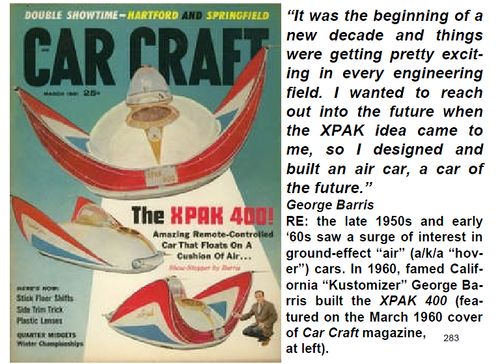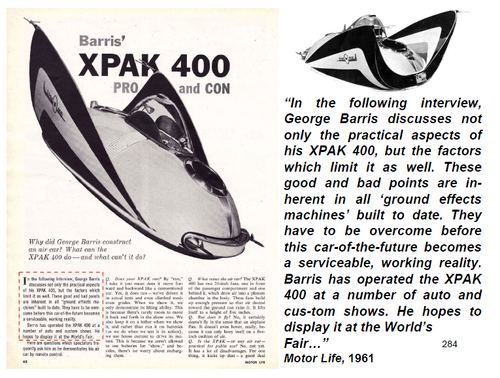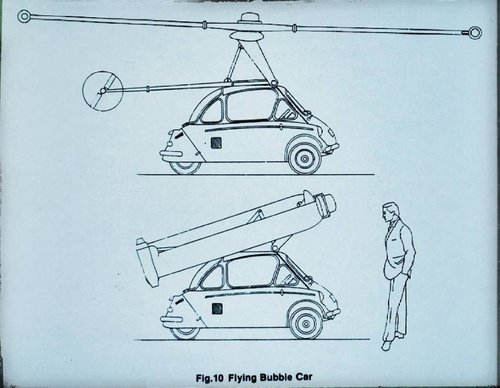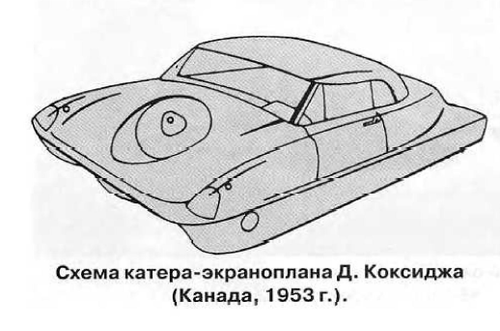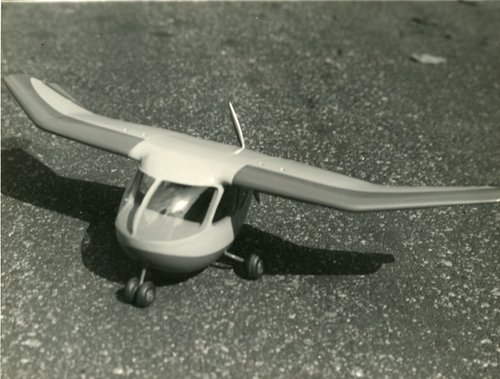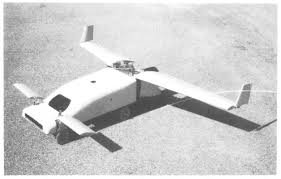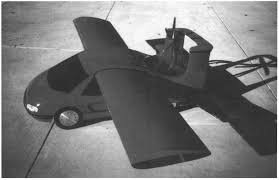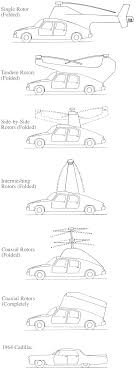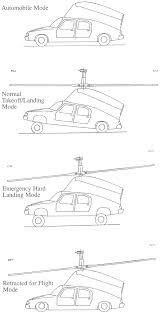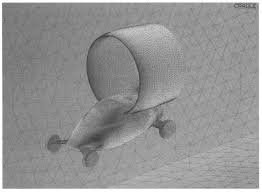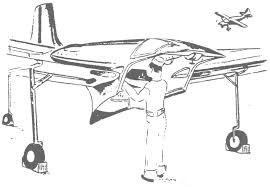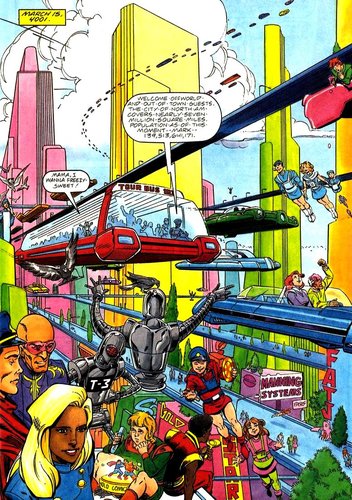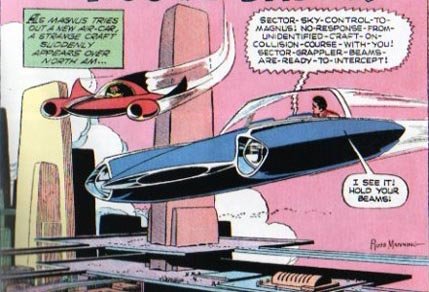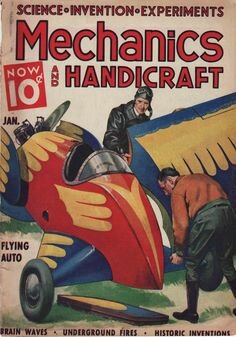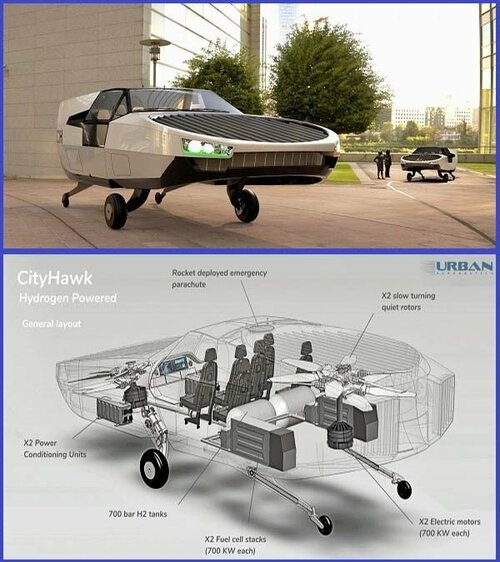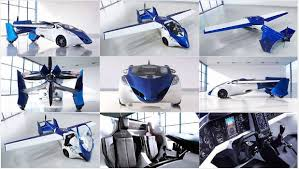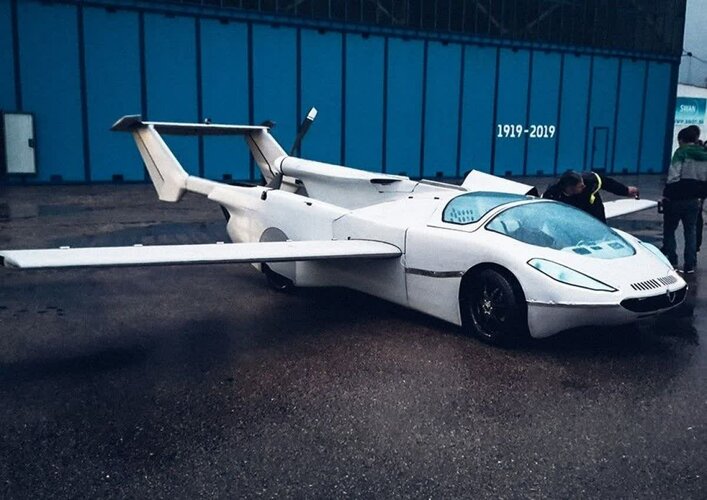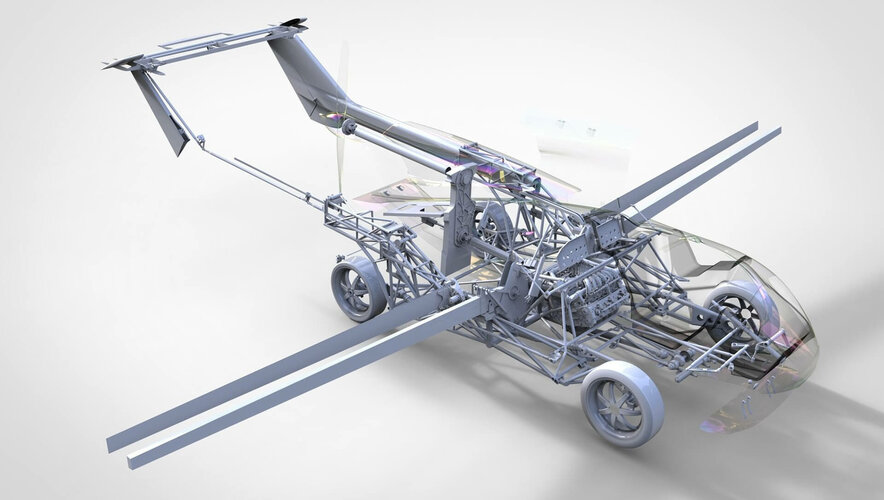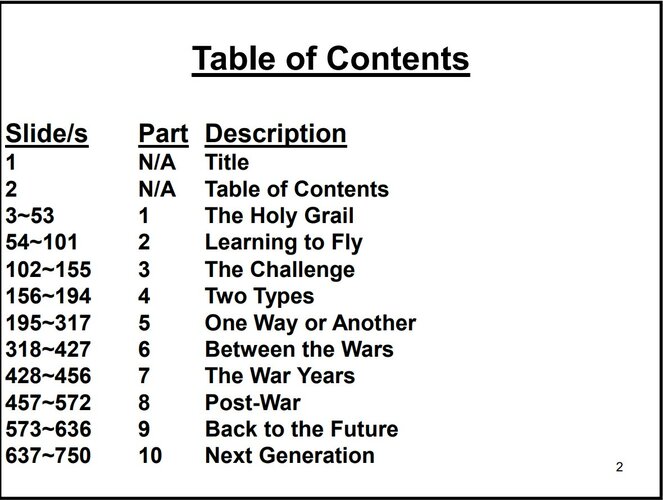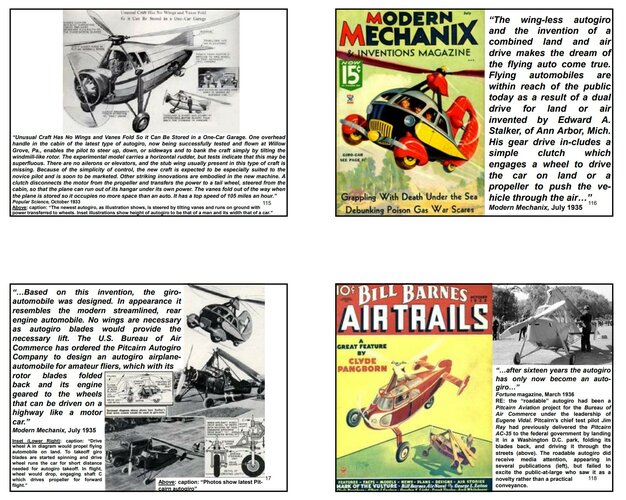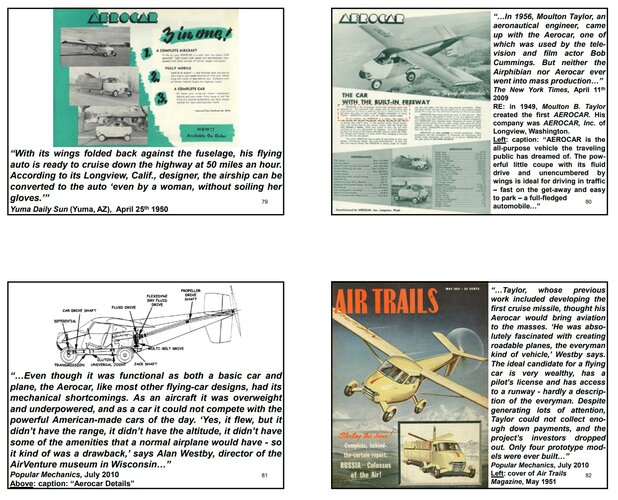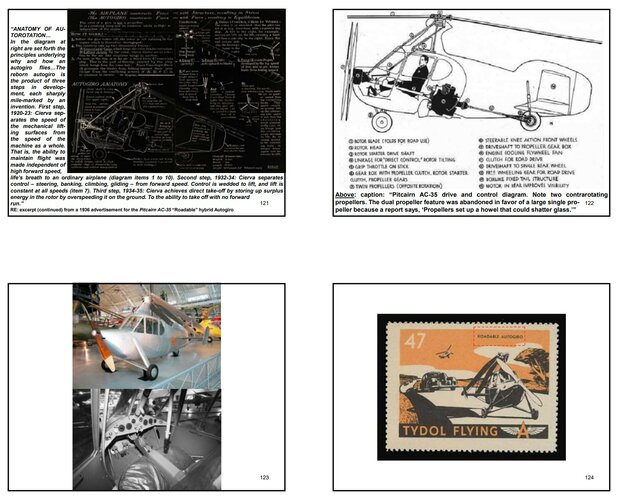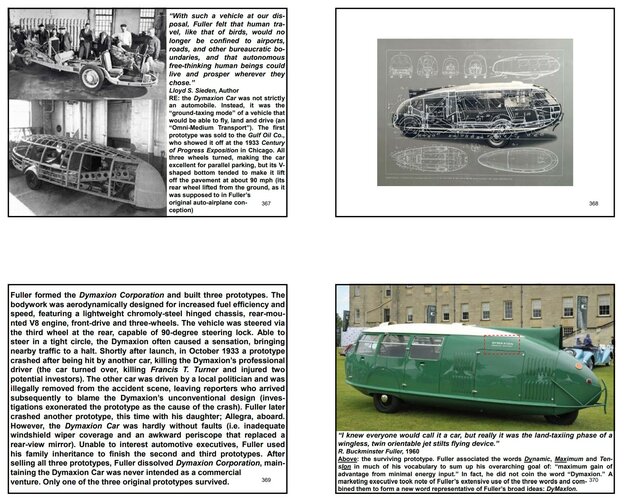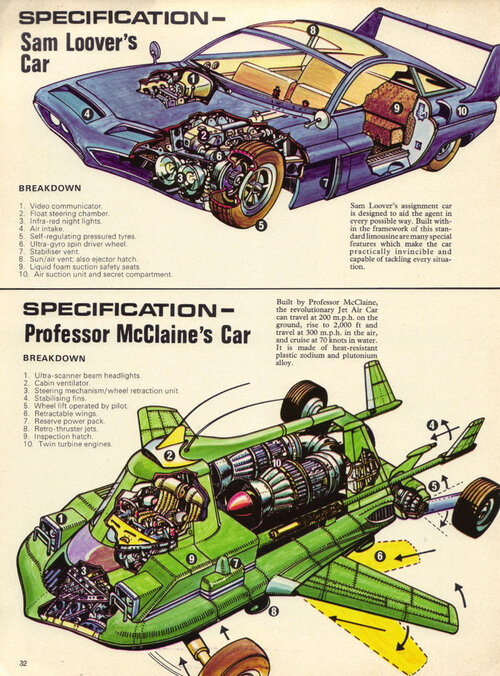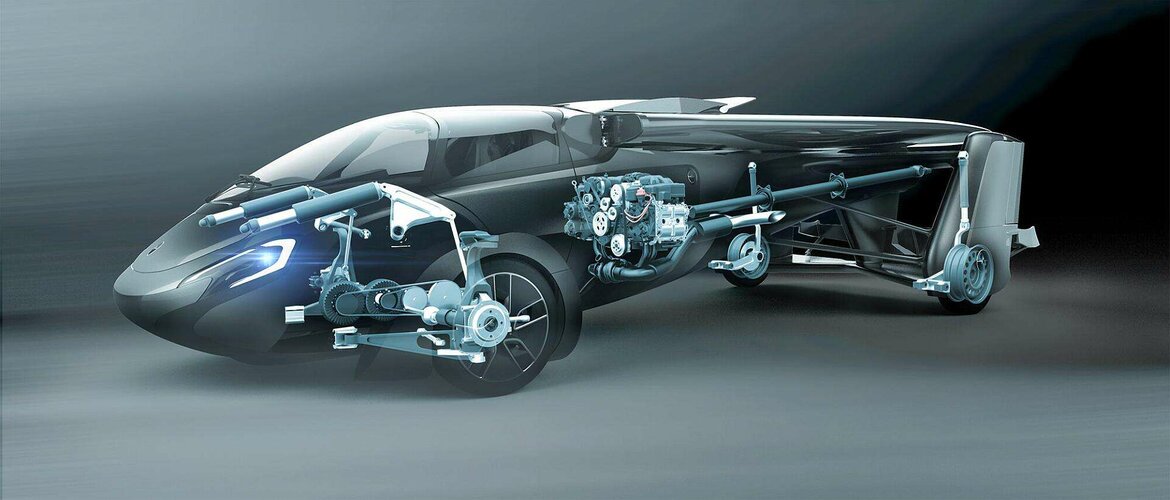You are using an out of date browser. It may not display this or other websites correctly.
You should upgrade or use an alternative browser.
You should upgrade or use an alternative browser.
Flying Cars And Roadable Aircraft
- Thread starter Justo Miranda
- Start date
- Joined
- 27 September 2006
- Messages
- 6,416
- Reaction score
- 6,805
The flying car in sci fi stories usually relies for lift on some form of "anti-gravity" lift engine. That is certainly true of Syd Mead's famous concept art. This removes the downblast we know from Harriers and Helicopters.
Until such an engine is designed a true flying car as opposed to a roadable helicopter is a pipedream
Until such an engine is designed a true flying car as opposed to a roadable helicopter is a pipedream
- Joined
- 26 May 2006
- Messages
- 34,871
- Reaction score
- 15,733
Hi,
a flying Bubble Car ?;

a flying Bubble Car ?;
Stingray's Rotorcraft Forum
Discussion forum about helicopters and other rotorcraft - a part of the world's largest rotorcraft archive, "Stingray's List of Rotorcraft"
stingraysrotorforum.activeboard.com
Attachments
Charlesferdinand
amateur theologian
- Joined
- 24 October 2013
- Messages
- 172
- Reaction score
- 274
Searching for an Isetta with a rotor, I found this https://www.pinterest.co.kr/pin/46232333648137819/
But that seems to be an art project rather than an actual vehicle. Seeing that a standard Isetta engine is supposed to have all of 12 horsepower for 350 kg, I am sceptical.
But that seems to be an art project rather than an actual vehicle. Seeing that a standard Isetta engine is supposed to have all of 12 horsepower for 350 kg, I am sceptical.
jmspeedfreak
ACCESS: Restricted
- Joined
- 23 September 2008
- Messages
- 32
- Reaction score
- 56
The most cars on the road have one passenger. Making a flying aircraft for one person is not unreasonable provided the endurance and/or L/D targets in cruise are sensible. I. E. Not a flying mega drone.
- Joined
- 9 October 2009
- Messages
- 21,944
- Reaction score
- 13,576
- Joined
- 9 October 2009
- Messages
- 21,944
- Reaction score
- 13,576
thebre4ker 4 points · 2 days ago
The top image is the cover, depicting the vehicle’s use alongside contemporary modes of transportation. The bottom image is an illustrated inner-page placing the Levacar in the lineage of transportation technologies, as the next stage in its evolution beyond jet powered flight.
The idea was a vehicle without wheels, that instead rode atop “levapads” that produced a cushion of air, pumped between it and the steel rail that served as a road. Propelled forward with propellers or jets, it would be most economical at speeds of 125mph, but could go as fast as 500mph. And while there was a small single-passenger Levacar built as a proof of concept, the intent was for this to be the future of ground-based public transportation. With larger Levacars like the imagined “City-Center Express,” the technology could carry 40 passengers or more from city to city, at the same speeds as commercial aircraft, using a fraction of the power.
After laying all this out, the brochure ends with the question, “What will the future hold for the Levacar?”
Credit: https://rogerstrunk.com/
Last edited:
GreatJimbo
ACCESS: Restricted
- Joined
- 8 May 2019
- Messages
- 21
- Reaction score
- 90
If you are interested I have done profiles of the Curtiss Autoplane and posted them in the artwork area here:
https://www.secretprojects.co.uk/threads/is-it-a-car-a-plane-its-the-curtiss-autoplane.34786/
My opinion on flying cars or roadable aircraft is that it will not come about until they are self driving / flying because I'm sure that most of us have seen the multitudes of idiot drivers out there and I could only imagine the carnage that would result from them attempting to operate in 3d space. I consider myself a good driver but would hesitate to take my skills into the air.
https://www.secretprojects.co.uk/threads/is-it-a-car-a-plane-its-the-curtiss-autoplane.34786/
My opinion on flying cars or roadable aircraft is that it will not come about until they are self driving / flying because I'm sure that most of us have seen the multitudes of idiot drivers out there and I could only imagine the carnage that would result from them attempting to operate in 3d space. I consider myself a good driver but would hesitate to take my skills into the air.
Charlesferdinand
amateur theologian
- Joined
- 24 October 2013
- Messages
- 172
- Reaction score
- 274
That sounds a lot like the Aérotrain of Jean Bertin.
thebre4ker 4 points · 2 days ago
The top image is the cover, depicting the vehicle’s use alongside contemporary modes of transportation. The bottom image is an illustrated inner-page placing the Levacar in the lineage of transportation technologies, as the next stage in its evolution beyond jet powered flight.
The idea was a vehicle without wheels, that instead rode atop “levapads” that produced a cushion of air, pumped between it and the steel rail that served as a road. Propelled forward with propellers or jets, it would be most economical at speeds of 125mph, but could go as fast as 500mph. And while there was a small single-passenger Levacar built as a proof of concept, the intent was for this to be the future of ground-based public transportation. With larger Levacars like the imagined “City-Center Express,” the technology could carry 40 passengers or more from city to city, at the same speeds as commercial aircraft, using a fraction of the power.
After laying all this out, the brochure ends with the question, “What will the future hold for the Levacar?”
Credit: https://rogerstrunk.com/
- Joined
- 3 September 2006
- Messages
- 1,474
- Reaction score
- 1,468
it was a Canadian attempt at a flying boat rather than flying car. In reality more a hovercraft than an ekranoplane.
It failed to fly.
See https://military.wikireading.ru/54944
It failed to fly.
See https://military.wikireading.ru/54944
- Joined
- 9 October 2009
- Messages
- 21,944
- Reaction score
- 13,576
DNyuz - Latest Breaking U.S. News
Latest Breaking News, U.S. and World Politics, Crime, Business, Science, Technology, Autos, Entertainment, Culture, Movie, Music, Sports.
dnyuz.com
- Joined
- 26 May 2006
- Messages
- 34,871
- Reaction score
- 15,733
Gero Tailless convertible airplane and roadmobile project
From the SDASM archives, a set of pictures of the Gero Roadmobile, a tailless convertible airplane and roadmobile project by Adelard J Gero Jr.
View: https://www.flickr.com/photos/sdasmarchives/31098607464/in/photostream/
And G. Bishop identified a patent that seems relevant: https://www.google.com/patents/US2609167
The wings look rather worrying to me...
Hi,
View: https://www.flickr.com/photos/sdasmarchives/31565183160
Attachments
dannydale
ACCESS: Top Secret
- Joined
- 13 May 2007
- Messages
- 545
- Reaction score
- 410
It looks like a lifting body reentry vehicle trying to be a 1957 Chevy.Finally.
- Joined
- 26 May 2006
- Messages
- 34,871
- Reaction score
- 15,733
Hi,
here is some flying car and roadable helicopter to ID ?,I don't know if they contain a
hypothetical designs or not ?.
here is some flying car and roadable helicopter to ID ?,I don't know if they contain a
hypothetical designs or not ?.
Attachments
Last edited:
- Joined
- 9 October 2009
- Messages
- 21,944
- Reaction score
- 13,576

Meet the Australian millionaire who invented a flying car inspired by Star Wars
F1 of the skies will start in 2021 - and it’s not as dangerous as you might think
richard B
ACCESS: Secret
- Joined
- 17 August 2006
- Messages
- 343
- Reaction score
- 498
- Joined
- 27 September 2006
- Messages
- 6,416
- Reaction score
- 6,805
Charlesferdinand
amateur theologian
- Joined
- 24 October 2013
- Messages
- 172
- Reaction score
- 274
I recently came across a TV news item about the Dutch PAL-V autogyro flying car. Estimated delivery times remain unchanged: in two years time. Deliveries were expected in two years when I first heard about the project back in 2017, and now they are still saying in two years.
As I said earlier in this thread, I don't think there is anything technically unfeasible about the project, it is just that the market doesn't exist.
Here it is
View: https://www.youtube.com/watch?v=fFW_0C7yFCI
As I said earlier in this thread, I don't think there is anything technically unfeasible about the project, it is just that the market doesn't exist.
Here it is
- Joined
- 9 October 2009
- Messages
- 21,944
- Reaction score
- 13,576

Car that can turn into plane to 'go on sale within next six months'
The AirCar V5 is the brainchild of a Slovakian professor who has been working on the concept for 30 years
EDIT: Funny thing, the forum thought this was a first post from a new user when I submitted this post, probably because I accidentally first tried to post it while logged out.
- Joined
- 9 October 2009
- Messages
- 21,944
- Reaction score
- 13,576

GM Reveals Electric Van and Delves Into Flying Cars - Slashdot
General Motors unveiled a new electric van and revealed potential plans to delve into flying cars, sending its stock soaring by as much as 8.8% to $48.95 a share. CNBC reports: The EV600 electric van is scheduled to go on sale later this year through a new commercial business unit of GM's...
tech.slashdot.org
Jules Mandelker, also known as Ulysse, a teenager living in Chicoutimi (Québec), in the Lac St-Jean area, may have been the first Quebecker to design his own airplane. This very small biplane, built no later than the mid-20s, when Mandelker was 16 or so, probably never flew. We know for a fact it was never registered. Its final whereabouts are unknown.
A decade later, this francophone jeweler fascinated by flight designed a most intriguing vehicle, possibly the most original Canadian homebuilt airplane of the interwar years. As described in an article published in the January 1938 issue of the American magazine Mechanics and Handicraft, it was somewhat egg-like in appearance. An air-cooled engine mounted in the rear drove a pusher propeller. The vehicle could be fitted with wheels, skis or floats. The main body was red, with yellow markings. The twin rudders and landing gear fairings, on the other hand, were blue and yellow.
If one is to believe the text, and the full colour cover illustration on the cover of the magazine, the Mandelker flying car came - or was to provided - with a set of blue and yellow wings, mounted low on the fuselage. If need be, these wings could be strapped to the sides of the vehicle. In all likelihood, the flying car never actually flew but was said to reach very high speeds on smooth ice. Its final whereabouts are also unknown.
A decade later, this francophone jeweler fascinated by flight designed a most intriguing vehicle, possibly the most original Canadian homebuilt airplane of the interwar years. As described in an article published in the January 1938 issue of the American magazine Mechanics and Handicraft, it was somewhat egg-like in appearance. An air-cooled engine mounted in the rear drove a pusher propeller. The vehicle could be fitted with wheels, skis or floats. The main body was red, with yellow markings. The twin rudders and landing gear fairings, on the other hand, were blue and yellow.
If one is to believe the text, and the full colour cover illustration on the cover of the magazine, the Mandelker flying car came - or was to provided - with a set of blue and yellow wings, mounted low on the fuselage. If need be, these wings could be strapped to the sides of the vehicle. In all likelihood, the flying car never actually flew but was said to reach very high speeds on smooth ice. Its final whereabouts are also unknown.
Attachments
Conspirator
CLEARANCE: L5
- Joined
- 14 January 2021
- Messages
- 324
- Reaction score
- 229
Charlesferdinand
amateur theologian
- Joined
- 24 October 2013
- Messages
- 172
- Reaction score
- 274
A ducted fan and a fuel cell. This must be the future.CityHawk Aircar hidrogen fuel cell
View attachment 648638
Conspirator
CLEARANCE: L5
- Joined
- 14 January 2021
- Messages
- 324
- Reaction score
- 229
are the wings/tail/prop removable?Cutaway Klein Visión AircarView attachment 648651
- Joined
- 28 January 2008
- Messages
- 635
- Reaction score
- 511
A flying car from the 90's !
Two clippings from either Air Pictorial, Air International or Air Enthusiast of a Citroen astride a Boeing 707.
I think it was for a Citroen BX19 TV advert from around 1990-91 and was filmed in France.
Two clippings from either Air Pictorial, Air International or Air Enthusiast of a Citroen astride a Boeing 707.
I think it was for a Citroen BX19 TV advert from around 1990-91 and was filmed in France.
Attachments
Conspirator
CLEARANCE: L5
- Joined
- 14 January 2021
- Messages
- 324
- Reaction score
- 229
were they testing the weight capabilities of the jet?A flying car from the 90's !
Two clippings from either Air Pictorial, Air International or Air Enthusiast of a Citroen astride a Boeing 707.
I think it was for a Citroen BX19 TV advert from around 1990-91 and was filmed in France.
Motocar
I really should change my personal text
- Joined
- 16 May 2014
- Messages
- 1,075
- Reaction score
- 1,125
The new concept for racing F1 Aircar...!
 newatlas.com
newatlas.com
View: https://youtu.be/Vv1PxhHdAzA?t=40
Hydrogen-electric flying car looks to take F1 racing airborne
By C.C. WeissNew Atlas - New Technology & Science News
Gizmag is now New Atlas. Extraordinary ideas moving the world forward.
Charlesferdinand
amateur theologian
- Joined
- 24 October 2013
- Messages
- 172
- Reaction score
- 274
The question of flying cars is usually framed as an engineering challenge, but the real problem is economics. David Lister in 'The Dark Age of Tanks' has some interesting figures about the British P35 jumping jeep project of the 60s. In 1966, BAC had forecast that such a vehicle would cost about 45-50.000 GBP. At the time, a Ferret scout car was 7.000 GBP, a two seat helicopter cost 20.000 GBP and a Westland Scout helicopter 75.000 GBP. As there was no guarantee the actual price of the P35 wouldn't go up, and the War Office was perenially strapped for cash, they gave up on the whole idea.
- Joined
- 18 June 2009
- Messages
- 1,412
- Reaction score
- 2,494
At this link is a 750 slide pdf presentation called The Roadable Aircraft Story. It apparently is a handout for an online course on flying cars. I imagine it will find a receptive audience in this thread.
Attachments
- Joined
- 18 June 2009
- Messages
- 1,412
- Reaction score
- 2,494
Charlesferdinand
amateur theologian
- Joined
- 24 October 2013
- Messages
- 172
- Reaction score
- 274
Another legal hurdle taken for the PAL-V Liberty

 www.flightglobal.com
www.flightglobal.com

EASA shapes certification basis for Liberty ‘flying car’ gyroplane
European safety authorities have finalised a certification basis for a convertible roadworthy rotorcraft, the PAL-V Liberty gyroplane, enabling its developer to accelerate compliance demonstration. The European Union Aviation Safety Agency says the certification specifications for rotorcraft are...
Charlesferdinand
amateur theologian
- Joined
- 24 October 2013
- Messages
- 172
- Reaction score
- 274
Armoures Archives has made a video about flying jeep/truck projects for the British army in the 60s
View: https://www.youtube.com/watch?v=-S90MWX3I0A
Motocar
I really should change my personal text
- Joined
- 16 May 2014
- Messages
- 1,075
- Reaction score
- 1,125
Web Sky Commuter

 paleofuture.gizmodo.com
paleofuture.gizmodo.com

Flying Car Prototype From 1990 Going Up For Auction
Want to own your very own flying car? Will you settle for a prototype that never left the ground? Well then you're in luck! Because the Barrett-Jackson auction in Arizona has a 1990 prototype with your name on it.
 paleofuture.gizmodo.com
paleofuture.gizmodo.com
Similar threads
-
Walter Wiesske air scooter, anybody?
- Started by Armin Derer
- Replies: 6
-
-
Suggesting from Flightglobal for flying car
- Started by hesham
- Replies: 1
-
-
Bud Martin's strange designs: Paraplane, Air Car, Roadster...
- Started by mz
- Replies: 7

